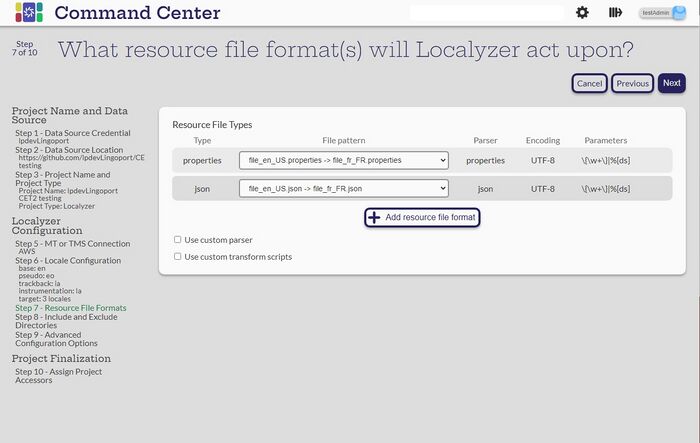Difference between revisions of "Resource File(s) Format"
(→Using Custom Resource File Types) |
(→File Name Pattern) |
||
| Line 28: | Line 28: | ||
<code>*-l_c-v</code> -> <code>file1-zh_hant-tw.properties</code> |
<code>*-l_c-v</code> -> <code>file1-zh_hant-tw.properties</code> |
||
| + | |||
<code>*_l-c-v</code> -> <code>file1_zh-hant-tw.properties</code> |
<code>*_l-c-v</code> -> <code>file1_zh-hant-tw.properties</code> |
||
| + | |||
<code>l_c-v</code> -> <code>zh_hant-tw.properties</code> |
<code>l_c-v</code> -> <code>zh_hant-tw.properties</code> |
||
Revision as of 22:12, 13 September 2023
Contents
Introduction
- Select the Resource File Types that are to be translated. Verify that the file pattern is correct.
For example if the base resource file is resource.properties, then the file pattern should be file.properties -> file_fr_FR.properties.
If the base resource file is resource_en_US.properties then the file pattern should be file_en_US.properties -> file_fr_FR.properties.
- Select Use XML parser file or Use custom transform scripts if there are already appropriate files defined in the Setting -> System Files -> XML Parser Files or Transform Folders
Select Next
Step 8: Set up optional include or exclude patterns
<== Back to Step 6: What are the Localyzer locales?
Using Custom Resource File Types
In the event that the file types and patterns in your repository don’t match any of the existing options, custom resource types can be configured. To add a custom resource file type, select the Add resource file format button and choose the custom option. Once added, a new row with many options to customize will appear
File Name Pattern
The File name pattern determines how Localyzer parses locale information from the filename. Both the file name pattern and the file location pattern can be used together, but only one or the other is required. The pattern must contain l, c, and v, or LCID. The pattern cannot contain /, \\, or any letter other than l, c, or v, or the continuous string LCID. The pattern may contain * as a wildcard to indicate “the rest of the file name,” but it must be the very first character of the pattern. Below are some example file name patterns with a hypothetical properties file that they could map to:
*-l_c-v -> file1-zh_hant-tw.properties
*_l-c-v -> file1_zh-hant-tw.properties
l_c-v -> zh_hant-tw.properties
Additionally under the file name pattern column, you have the option to use the pattern on target locale files only, or to also apply the pattern when searching for the base locale files. By default, with “targets only” selected, Localyzer will use any non-target file that matches the include and exclude patterns as a base file. This allows for example file1.properties to be used as a base file even when it has nothing in the name to indicate the locale. If “all locales” is selected, then the base target files must also obey the locale pattern; for example if your base locale is en_US, then your base target files would have to look something like file1-en_US.properties, depending on how the file name pattern is configured.

